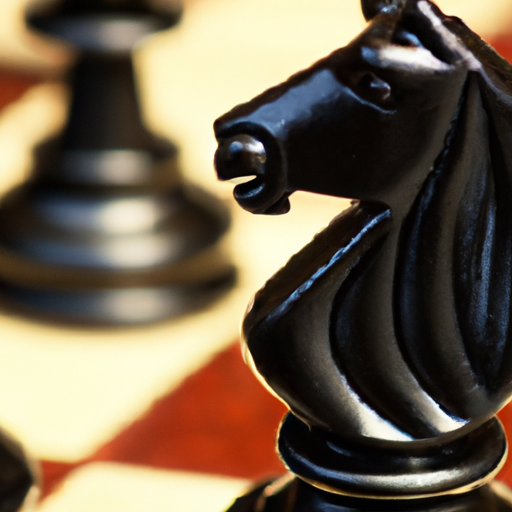Are you ready to take your chess game to the next level? If you’re looking to elevate your strategic skills and become a chess wizard, then it’s time to explore the world of the Benoni Defense. This powerful opening can give you a strategic advantage by allowing you to attack your opponent with precision and finesse. In this article, we’ll delve into the intricacies of the Benoni Defense, uncovering its secrets and showing you how to leverage it effectively. Get ready to unleash your inner grandmaster and dominate the chessboard with strategic prowess.

Overview of the Benoni Defense
The Benoni Defense is a chess opening that is known for its counterattacking and dynamic nature. It is a strategic choice for black, as it aims to imbalance the position and create opportunities for both tactical and positional advantages. Understanding the key concepts, plans, and tactics of the Benoni Defense can help you navigate through its complexities and use it effectively in your games.
Definition of the Benoni Defense
The Benoni Defense is characterized by the moves 1.d4 Nf6 2.c4 c5 3.d5 e6. It is a type of hypermodern defense that allows white to occupy the center with their pawns while black counterattacks from the flank. The typical pawn structure involves black’s pawns on d6, e6, and g6, with a potential fianchetto setup. The Benoni Defense is known for its dynamic piece play and counterattacking options.
History of the Benoni Defense
The Benoni Defense was named after the town of Benoni in South Africa, where it was first played in the late 19th century. It gained popularity in the mid-20th century, with Grandmasters such as Mikhail Tal and Bobby Fischer employing it successfully in their games. The Benoni Defense has stood the test of time and continues to be a favorite choice for players who enjoy tactical battles and dynamic positions.

Common Variations
There are several variations within the Benoni Defense, each with its own strategic objectives and nuances. Some common variations include the Classical Benoni, Modern Benoni, and Fianchetto Benoni. The Classical Benoni focuses on solid pawn structure and central control, while the Modern Benoni aims for dynamic piece play and counterattacks. The Fianchetto Benoni emphasizes the development of the bishop on g7 and a kingside attack. Familiarizing yourself with these variations can help you choose the one that suits your style of play.
Strategic Concepts in the Benoni Defense
Central Pawn Structure
The central pawn structure is a crucial aspect of the Benoni Defense. Black often aims to maintain a sturdy pawn chain with pawns on d6 and e6. This structure allows for flexibility in piece placement and provides a solid foundation for future attacks. Keeping the central pawns intact is important to prevent white from gaining a pawn break advantage.
Piece Activity
In the Benoni Defense, piece activity plays a significant role. Black aims to develop their pieces harmoniously and actively, with an emphasis on controlling key central squares. Active minor pieces can put pressure on white’s position and create opportunities for tactical strikes. However, it is essential to carefully coordinate piece activity to avoid leaving weak squares or pieces exposed to potential attacks.
Counterattacking Options
One of the defining characteristics of the Benoni Defense is its counterattacking nature. Black often sacrifices material to create imbalances and launch powerful counterattacks against white’s position. By carefully assessing the position and exploiting weaknesses, black can generate threats and put pressure on white’s pieces. The ability to find counterattacking options is crucial for success in the Benoni Defense.
The Benoni Defense as a Dynamic Opening
Imbalance of Pawn Structure
The Benoni Defense aims to create an imbalance in the pawn structure, disrupting white’s plans and creating opportunities for black’s counterplay. By allowing white to occupy the center with pawns while challenging them with flank attacks, black aims to make the position more dynamic and challenging to navigate. This imbalance often leads to unbalanced positions where tactical opportunities abound.
Initiative vs. Material
In the Benoni Defense, the balance between initiative and material is a key consideration. Black often sacrifices material to maintain a dynamic position and seize the initiative. While material is important, the ability to dictate the course of the game through active piece play and threats can outweigh the temporary material disadvantage. Evaluating the balance between initiative and material is crucial for making strategic decisions.
Dynamic Piece Play
Dynamic piece play is a hallmark of the Benoni Defense. Black aims to develop their pieces aggressively, actively contesting control of key squares and squares supporting possible pawn breaks. Well-placed knights, bishops, and the queen can coordinate their efforts to put pressure on white’s position and create tactical opportunities. Dynamic piece play is essential in exploiting weaknesses and launching effective counterattacks.

Understanding the Benoni Defense
Ideal Piece Placement
In the Benoni Defense, achieving ideal piece placement is vital for success. Knights and bishops often find optimal squares to put pressure on white’s position, control key squares, and support potential pawn breaks. The queen typically plays an active role in coordinating the pieces and launching attacks. It is crucial to consider the long-term prospects of piece placement and anticipate potential future openings and tactical opportunities.
Key Squares and Outposts
Identifying and controlling key squares is essential in the Benoni Defense. These squares serve as strong bases for pieces, provide control over important central areas, and support pawn breaks. Outposts, which are squares that cannot be easily attacked by the opponent’s pawns, often become crucial in establishing a strong piece presence. Recognizing the significance of key squares and outposts is vital for maximizing the effectiveness of your pieces.
Pawn Breaks
Pawn breaks are tactical maneuvers that disrupt the pawn structure and create opportunities for black’s counterplay. By carefully assessing the position and identifying weak points, black can initiate pawn breaks that open up lines, create imbalances, and unleash the potential of their pieces. Timing and accurate calculation are crucial when executing pawn breaks, as they can significantly shift the dynamics of the position.
Typical Plans and Strategies in the Benoni Defense
Queenside Expansion
A common plan in the Benoni Defense involves expanding on the queenside. Black may aim to push pawns on the b and c files, creating pressure and potential weaknesses in white’s camp. This expansion often creates opportunities for piece activity and tactical strikes, as well as potential threats against white’s king. Queenside expansion is a strategic choice that requires careful pawn structure management and awareness of potential counterplay from white.
Kingside Attack
Another typical plan in the Benoni Defense is launching a kingside attack. By coordinating their minor pieces and the queen, black can create threats against white’s king and initiate a powerful attack. Kingside attacks often involve sacrificing material to open lines and exploit weaknesses in white’s position. Sound calculation and evaluation skills are crucial for executing successful kingside attacks.
Central Control
Maintaining central control is a strategic objective in the Benoni Defense. By actively contesting the central squares and preventing white’s pawn breaks, black can limit white’s options and gain more maneuverability for their pieces. Central control also allows black to dictate the flow of the game and create opportunities for tactical strikes and counterattacks. A solid understanding of central control and the ability to exploit it effectively are key skills to develop in the Benoni Defense.
Common Themes and Tactics in the Benoni Defense
Sacrifices for Initiative
Sacrificing material for the sake of gaining initiative and dynamic play is a common theme in the Benoni Defense. Black often utilizes tactical strikes, sacrificing pawns or even pieces to disrupt white’s position and seize the initiative. These sacrifices can create imbalances, open lines, and generate threats that put white on the defensive. Calculating the consequences of sacrifices and accurately assessing the resulting position are necessary skills in the Benoni Defense.
Counterattacks on Weaknesses
The ability to counterattack on weaknesses is a vital tactical aspect of the Benoni Defense. By identifying weak points in white’s position, black can launch powerful strikes that exploit vulnerabilities and force white to defend. Counterattacks can come in the form of tactical combinations, aggressive piece play, or even sacrifices. Recognizing opportunities for counterplay and executing them with precision can disrupt white’s plans and create winning chances.
Trapping Opponent’s Pieces
Trapping opponent’s pieces is a tactical idea frequently employed in the Benoni Defense. By creating threats and applying pressure, black can force white’s pieces into unfavorable squares or even trap them. Trapped pieces can severely limit white’s options and provide black with a significant advantage. Sensing when a piece is vulnerable and seizing the opportunity to trap it requires tactical awareness and accurate calculation.
Key Positional and Tactical Ideas in the Benoni Defense
Double-Edged Nature of the Benoni
The Benoni Defense is known for its double-edged nature, where both sides have attacking opportunities and potential weaknesses. The imbalanced pawn structure and dynamic piece play create a position rich in both tactical and positional possibilities. Understanding the risks and rewards of the Benoni Defense and making strategic decisions accordingly is essential for success.
Exploiting Weaknesses in White’s Position
Identifying and exploiting weaknesses in white’s position is a key positional idea in the Benoni Defense. Whether it is weak squares, poorly placed pieces, or vulnerable pawn structure, black looks for opportunities to apply pressure and launch attacks. Weaknesses can become targets for tactical strikes or can be exploited through strategic maneuvering. A sharp eye for weaknesses and the ability to capitalize on them are valuable skills in the Benoni Defense.
Piece Combinations and Exchanges
Piece combinations and exchanges play a significant role in the Benoni Defense. By carefully coordinating the movements of pieces and initiating exchanges, black can reshape the position, open lines, or eliminate key defenders of white’s position. Active piece combinations can create tactical opportunities, while well-executed exchanges can lead to a more favorable pawn structure or positional advantage. Understanding the potential impact of piece combinations and exchanges is crucial for effective play in the Benoni Defense.
Famous Benoni Defense Games and Players
Notable Games
Several famous games in chess history have featured the Benoni Defense. One notable game is the encounter between Mikhail Tal and Garry Kasparov in 1982. Tal, known for his aggressive and tactical style, showcased the power of the Benoni Defense by launching a fierce kingside attack against Kasparov’s position. The game, filled with sacrifices and tactical fireworks, ended in Tal’s victory, leaving a lasting impression on the chess world.
Prominent Benoni Players
Throughout history, many renowned players have employed the Benoni Defense in their games. Grandmasters such as Bobby Fischer and Mikhail Tal have left their mark with their brilliant execution of the Benoni Defense. Fischer’s game against Bent Larsen in 1971 showcased his ability to generate counterplay and launch devastating attacks. Tal’s encounters against strong opponents, including his game against Wolfgang Uhlmann in 1964, demonstrated his tactical brilliance and the power of the Benoni Defense.
Historical Battles
The Benoni Defense has also played a significant role in historical battles between top players. Famous encounters between Anatoly Karpov and Viktor Korchnoi during their World Championship matches in 1978 and 1981 highlighted the strategic complexity and dynamic nature of the Benoni Defense. These battles showcased the efforts of both players to outmaneuver and outplay their opponents in the Benoni Defense, leaving lasting impressions in chess history.
Tips and Advice for Playing the Benoni Defense
Preparation and Opening Repertoire
Preparation is crucial when playing the Benoni Defense. Study the typical pawn structures, piece placements, and tactical motifs for the various variations within the Benoni Defense. Build a well-rounded opening repertoire that suits your playing style and addresses the different possibilities that arise from the Benoni Defense. By being well-prepared, you will have a better understanding of the ideas and variations, allowing you to make informed decisions during the game.
Calculation and Evaluation Skills
The Benoni Defense often leads to complex positions that require accurate calculation and evaluation skills. Develop your ability to calculate tactical variations, assess imbalances, and accurately evaluate resulting positions. Calculation exercises, analyzing master games, and solving tactical puzzles can sharpen your calculation and evaluation skills, enabling you to make sound decisions and find winning opportunities in the Benoni Defense.
Improving Dynamic Play
Dynamic play is a key aspect of the Benoni Defense. Enhance your dynamic play skills by practicing active piece placement, proactive piece coordination, and creative attacking ideas. Study games played by strong Benoni Defense players to gain insights into their dynamic approach. Actively seek initiatives and opportunities for counterplay, and develop your ability to exploit imbalances for tactical strikes. Becoming proficient in dynamic play will greatly enhance your performance in the Benoni Defense.
Common Mistakes to Avoid in the Benoni Defense
Neglecting King’s Safety
In the pursuit of aggressive play and counterattacks, it’s important not to neglect the safety of your king. The Benoni Defense often leads to sharp positions where both sides have attacking chances. However, be mindful of potential threats to your king’s safety and ensure that you have adequate defensive measures in place. Failing to prioritize your king’s safety can lead to devastating attacks from your opponent.
Failing to Capitalize on Counterplay
The Benoni Defense offers ample opportunities for counterplay. It is essential not to miss or underestimate these chances. By staying alert to potential weaknesses in your opponent’s position and seizing the initiative when it arises, you can create powerful counterattacks and turn the tables in the game. Failing to capitalize on counterplay can prevent you from achieving a desirable position or even allow your opponent to regain control.
Neglecting Piece Coordination
Coordination among your pieces is crucial in the Benoni Defense. Neglecting to coordinate your pieces effectively can result in limited mobility, leaving them vulnerable to attacks or unable to exert pressure on your opponent’s position. Pay attention to piece placement, create harmonious piece setups, and envision future possibilities that arise from coordinated piece play. Proper coordination enhances your chances of success in the Benoni Defense.
In conclusion, the Benoni Defense is a dynamic and counterattacking opening that provides ample opportunities for both tactical strikes and positional advantages. Understanding the key strategic concepts, typical plans and strategies, as well as common themes and tactics, is essential for successfully utilizing the Benoni Defense. Study famous games, learn from prominent players, and continuously work on improving your calculation, evaluation, and dynamic play skills to unlock the full potential of the Benoni Defense in your games. With dedication and practice, you can become a formidable player of the Benoni Defense and elevate your chess game to new heights.



